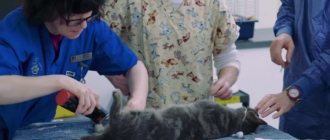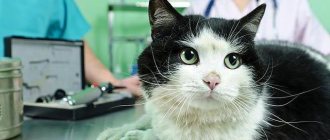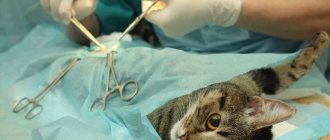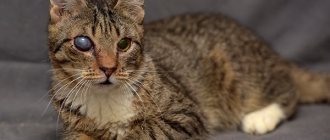Removal of the male gonads is the most common and minimally invasive operation in veterinary medicine. It is easy to perform and does not require long rehabilitation. The only exception, which requires the most serious approach to the procedure, is cryptorchidism in cats. This natural anomaly is fraught with many unpleasant consequences, so such animals must be castrated.
Is cryptorchidism a disease in cats?
The reason for castration of a cryptorchid cat is not obvious to every owner. In order to understand this issue, it is enough to clarify the essence of this concept and determine the level of its danger.
What is cryptorchidism
Cryptorchidism in cats is a congenital anomaly that does not pose a threat to others. It manifests itself in the incorrect location of the testes (testicles) and excludes other physiological disorders. As a result of this anomaly, one or both organs do not descend into the scrotum, but remain in the inguinal canal or abdominal cavity.
Similar pathologies include monorchism and anorchism, which involve the congenital absence of one or both testes. If a cat has only one testicle, then his body has a low level of testosterone. This feature excludes interest in the opposite sex, so pets with this anomaly cannot participate in breeding.
The attraction to females in cryptorchid cats remains, and the need for castration is explained by the low quality of sperm. It is almost impossible to obtain offspring from such animals. Fortunately for breeders, the probability of giving birth to cryptorchids is no more than 3%.
What is the danger
The main purpose of the scrotum is to preserve the viability of sperm due to the lower temperature. The testes remaining in the peritoneum or inguinal canal are constantly overheated, which leads to the following complications:
- Loss of reproductive function
. If both testicles have not descended in a cat, he is diagnosed with infertility. With a unilateral form of pathology, only the quality of sperm suffers. Fertilization sometimes occurs, but is achieved with great difficulty.
- Hormonal disorders
. Due to the loss of testosterone, the pet develops feminization syndrome. The cat begins to attract other males, and its mammary glands enlarge. Another sign of this disorder is asymmetrical alopecia, accompanied by darkening of the skin in the bald area. Most often, the genitals of the animal become bald.
- Testicular torsion
. The unnatural position is accompanied by acute pain. The animal may suffer from internal bleeding due to damage to the spermatic artery.
- Oncology
. Lack of sperm and elevated temperature stimulate malignant tissue degeneration. Tumors are treatable only at the initial stage, but their timely diagnosis is complicated by a long asymptomatic course.
- Prostate diseases
. Any inflammatory process in the testes is accompanied by a sharp rush of blood to the prostate gland. This is fraught with the formation of stones and tumors.
- Inguinal hernia
. Develops due to non-fusion of the vaginal process of the peritoneum. As a result of its strangulation, the animal may die due to peritonitis.
Castration of a cryptorchid cat helps to avoid all these complications, so veterinarians recommend operating on your pet before alarming symptoms appear.
How to prepare an animal for surgery?
The timing of the operation should be discussed with your veterinarian. Before surgery, it is optimal to fast the animal for 4-6 hours. Also, to prepare for the operation, it is necessary to undergo a number of diagnostic measures, namely: General clinical and biochemical blood tests and screening ultrasound of the heart. If any deviations are determined, therapy is prescribed.
Castration of a male cryptorchid is the surgical removal of testes located outside the scrotum (in the groin, inguinal canal, abdominal cavity). There are three indications for this procedure: prevention of the development of neoplasms and torsion of undescended testes in an adult animal; correction of unwanted animal behavior; exclusion from breeding of a dog with cryptorchidism to prevent further hereditary transmission.
Most often, the testis is located subcutaneously in the groin area. To remove such a testis, the skin over it is cut. The testis is removed in a closed manner. Sutures are applied in two layers - on the subcutaneous fatty tissue and on the skin.
The most difficult thing when castrating a male cryptorchid is removing the testis located in the abdominal cavity or in the inguinal canal. In these cases, abdominal surgery is performed; The abdominal cavity is opened, an incision is made along the white line of the abdomen, usually to the right of the penis, and, under visual control, the vessels of the testis and spermatic cord are searched, the testis is localized and then removed.
Another option for collecting a testis from the abdominal cavity is endoscopic surgery. This type of surgery is not available in our veterinary clinic; doctors can only inform about the existence of this alternative.
There is also a chemical method of castration - the introduction of a subcutaneous implant containing gonadotropin releasing hormone. Used to induce temporary infertility in healthy, sexually mature male dogs, cats and ferrets. Temporary sterilization is indicated in case of unwanted mating at the moment or there are contraindications to surgery. The implant can suppress sexual function for up to six months.
What does a cryptorchid cat look like?
First of all, the anomaly affects the appearance of the scrotum. It loses its elasticity and wrinkles. Over time, changes appear in the proportions of the animal. The skeleton becomes more elegant and fragile, which is typical for females.
The main method of diagnosis is palpation, so most often the pathology is confirmed only during an examination by a veterinarian. When independently identifying the problem, it is recommended to take into account not only external signs, but also some behavioral changes.
Types of pathology
The most common type of cryptorchidism in cats is unilateral, involving the correct descent of the left or right testis. If the problem arises from both organs, then the pathology is called bilateral.
In addition to classification according to the number of “hidden” testicles, there is a division according to their location.
Abdominal
This type is not amenable to visual and manual diagnosis, since the testis is hidden behind the fatty layer of the abdominal cavity and is often underdeveloped. You can notice it among other internal organs only on an ultrasound.
Inguinal
The “hidden” testicle is located in the fat layer of the groin area. Due to its close location to the skin, it is easy to see and feel. The anomaly, resembling a small ball just above the scrotum, is especially noticeable in massive short-haired pets. Usually, owners mistake this subcutaneous tumor for cancer, so they immediately take their pet to a veterinary clinic for examination.
False
In this case, there is free movement of organs from the scrotum to the peritoneum and back. This happens due to stress and hypothermia. After eliminating the pathological factor, the organ returns to its proper place.
Secondary
A false-type complication that occurs due to the presence of adhesions in the peritoneum or excess accumulation of fat. As a result of these factors, the testes cannot return to their place, continuing to move freely along the inguinal canal and abdominal region.
Causes of cryptorchidism in cats
In the absence of pathology, the testes descend into the scrotum before the kitten reaches 6 months. If this does not happen, then the reason lies in:
- Hormonal disorders
. Due to insufficient testosterone, the force responsible for prolapse is reduced. As a result, the organ “freezes” somewhere along the way, without reaching the final goal.
- Infectious diseases of the mother or postpartum injuries
. There may also be danger in potent drugs used during pregnancy. Because of this, it is important to treat the animal only under the supervision of a veterinarian.
- Disturbances in the development of internal organs
. Natural descent is hindered by adhesions, a short spermatic cord, excess connective tissue and a too small opening in the inguinal canal.
- Testicle size
. If the norm is exceeded, passage of the testicle through the existing opening becomes impossible.
Of all the above reasons, only diseases in a pregnant cat can be prevented. The remaining cases do not depend on the conditions of detention and care, so the owner can only find out about them from a veterinarian.
Causes of anomalies and self-detection
It is very difficult to determine why a cat developed a pathology. Experts identify several reasons why this can happen. Factors contributing to the occurrence of cryptorchidism:
- Inheritance of mutation. It has not yet been established whether the mutation is transmitted to the offspring through the paternal or maternal line.
- Anatomical features. A very short testicular cord, the occurrence of adhesions or a narrow inguinal canal contribute to the failure of the testicle to descend into the scrotum.
- Injury while passing through the birth canal.
- The presence of infections during the cat’s pregnancy and the use of potent medications during this period.
- Hormonal disorders.
It is impossible to detect pathology at an early age. But if the kitten’s father is a cryptorchid, then there is a possibility that the anomaly will also appear in his offspring. As a rule, pathology is detected only after 6 months from birth. It is at this age that the testicles should descend into the scrotum. Therefore, at this time, cat owners are advised to take their animal to the veterinarian. Inguinal cryptorchidism is not difficult to detect. Other species are much more difficult to diagnose. Sometimes the abdominal form is very difficult to detect even with the help of ultrasound.
Diagnosis of the problem
The age of the animal is important for successful diagnosis. Due to the peculiarities of the development of the gonads, you have to wait until the pet reaches six months. This is often taken advantage of by scammers who keep silent about the presence of cryptorchidism in the cats they sell.
At the kitten's
The only way to check a kitten is to meet its father. When purchasing, be sure to request documents for both parents. If possible, get to know them in person, since in adult animals the problem is often visually noticeable.
In an adult animal
Diagnosis in adulthood depends on the type of pathology. In most cases, a visual inspection and palpation is sufficient for the veterinarian. If this is not enough, then ultrasound of the peritoneum and groin area is used. In rare cases, the abdominal type is discovered only during surgery.
Is it possible to independently detect cryptorchidism in a cat?
The inguinal type of pathology lends itself well to self-diagnosis. In addition to external changes, it is noted:
- Increased fascination with females, regardless of the presence of estrus. On the part of cats, a reverse reaction is observed, often accompanied by open aggression.
- Prolonged lack of fertilization, regardless of the number of matings performed. Only 40% manage to have offspring. In this case, the anomaly passes on to the kittens.
- Unusual posture when urinating. The cat urinates like a dog, raising its hind leg.
Particular attention should be paid to pain. This symptom appears very rarely and only during complications. If palpation of the groin or peritoneum causes severe pain to your pet, contact a veterinary clinic immediately. This reaction occurs when nerve canals are compressed, which is fraught with death and decomposition of the organ.
How is postoperative care provided?
The most commonly used anesthesia is muscle relaxants, drug-induced sleep, and epidural anesthesia. The timing of the animal's awakening is purely individual. The owner takes the animal from the veterinary clinic only at the moment of complete awakening. Owners are given detailed recommendations on post-operative care for the animal, and painkillers are also prescribed for use at home.
Upon arrival home, the dog should be placed in a warm, low place.
When applying external sutures, they should be protected from the animal’s licking either with a blanket or a protective collar (Elizabethan).
Treatment of seams is recommended with specialized sprays (Ranosol/Monclavit/Migstim type) once a day, and the treatment is carried out gently; in no case should you rub the seam, remove crusts, only gently wipe/soak. Removing the suture
material is produced in a clinical setting for 7-10 days (depending on the degree of healing).
It is also possible to apply a cosmetic suture, in which the suture material itself does not need to be removed, but such a suture also requires care. The type of wound closure depends on the animal's skin and the physician's preference.
Treatment options
Cryptorchidism in cats is treated with surgery or hormonal therapy. The first method is considered more effective, since, in addition to suppressing reproductive function, it eliminates the risk of developing a malignant tumor.
Hormone therapy
If the cause of the abnormalities is a lack of testosterone, then the pathology is treated with hormonal drugs. This therapy is contraindicated in pets under 1 year of age, as it can cause growth retardation and deviations in the development of the skeletal system.
The rare use of drug treatment is explained by its high cost and low effectiveness. When testosterone is withdrawn, the anomaly often returns. If everything went well, the animal will still not be able to participate in breeding. This is why cryptorchid cats usually undergo surgery to remove their reproductive organs.
Operation – specific castration
Surgery is performed at 7-9 months. Instead of sterilization, cryptorchid cats are castrated. Owners often confuse these concepts, dividing them by gender. In reality, the difference between these operations lies in the method of suppressing reproductive function. A sterilized pet loses the ability to inseminate while maintaining attraction, and a castrated pet loses both. The last option is most justified in the prevention of cancer.
The operation is performed under general anesthesia for 1.5 hours. Through the incision, the surgeon pulls out and cuts off the testicles, ligating or cauterizing the spermatic cord. In the case of the abdominal type of pathology, the vas deferens is first cut off, and the testes are pulled out through the abdominal cavity. At the end of the procedure, stitches are placed at the incision site.
Is it possible to remove just one testicle?
This option is possible, but ineffective. Left with one testicle, the cat will continue to leave scent marks, maintaining attraction and aggression. For this reason, it is safer and smarter to agree to a complete deletion.
Rehabilitation period
The recovery period after abdominal surgery is longer than after regular castration. Before the suture heals, try to pay a lot of attention to your pet, protecting it from injury and infection.
How is recovery going?
After anesthesia, slight lethargy and loss of coordination are acceptable. Provide your pet with a comfortable place on the floor and stop any attempts to climb higher. Due to impaired heat exchange, wrap it in a blanket, but keep it away from the radiator. Such a heat source can trigger the development of inflammation.
A hunger strike on the first day is natural, but dehydration should be avoided. If the animal refuses to drink on its own, then it needs to be given a drink after 2-3 hours from a pipette or syringe. In addition to the oral cavity, you will also have to moisten your eyes. The introduction of an anesthetic often disrupts natural blinking, which can lead to drying out of the mucous membranes.
Don’t be alarmed that a cat who has woken up from anesthesia walks around on its own. Place absorbent diapers under his sleeping area and change them regularly after getting wet. Be sure to eliminate drafts and keep the animal away from children and other pets. The operated pet will need not only warmth, but also a calm environment.
Pet care
The next day the animal can be fed. In the first week, it is better to use wet canned food or soaked dry food. Natural foods include light meat broths and slimy porridges.
To protect the seam from damage, a blanket is put on the cat. Additionally, a protective collar may be required to prevent the wound from licking. Treatment of the seam is permissible only as prescribed by a veterinarian, since ointments inhibit the process of tissue regeneration.
Possibility of complications
You will have to contact a veterinarian in case of prolonged refusal to eat (more than 1-2 days) and prolonged constipation (more than 2-3 days). Also a cause for concern is any change in the wound area: redness, severe swelling, suppuration, bleeding. If all recommendations are followed, including a two-week home quarantine, the likelihood of developing these complications is close to zero.
Unlike the standard disease, cryptorchidism is not dangerous in the short term. You shouldn’t rush to the vet headlong at the first sign of an abnormality. But it is also impossible to remain inactive, expecting possible complications.
The most reliable solution to this problem is castration. Despite the loss of value in breeding work, the operated cat retains the ability to participate in exhibitions and acquires a more friendly character. Approach the situation adequately, preventing the inheritance of the anomaly.
The article is for informational purposes only. Contact your veterinarian!
Caring for your dog after surgery
Typically, the pet regains consciousness after anesthesia 30-90 minutes after surgery. The time it takes for the condition to normalize depends on many factors: the dog’s age and weight, anesthesia drug, physiological state, etc. At this time, it is important to provide him with the necessary care.
Immediately after you pick up your dog from the clinic, wrap it in a thin blanket. Lay out a disposable diaper, since the pet is not yet fully in control of consciousness and may wet itself. When you arrive home, put the dog in a pre-prepared place. It should be a soft, clean bed in a quiet corner, without drafts, away from heating appliances. Turn your pet from side to side every half hour. At the same time, check if the diaper is wet. Replace with a clean one as needed.
When recovering from anesthesia, the dog may be disoriented in space. This is normal, no need to panic. Make sure that the animal is not injured. You can feed or water your dog only after all symptoms of lethargy have passed.
Rehabilitation will also require wound care. For 10-14 days, treat the seams with brilliant green 1-2 times a day. The doctor may prescribe another antiseptic. To avoid licking the stitches and complications, you can put a post-operative blanket on your pet. Usually 2 weeks after surgery, the sutures are safely removed.











